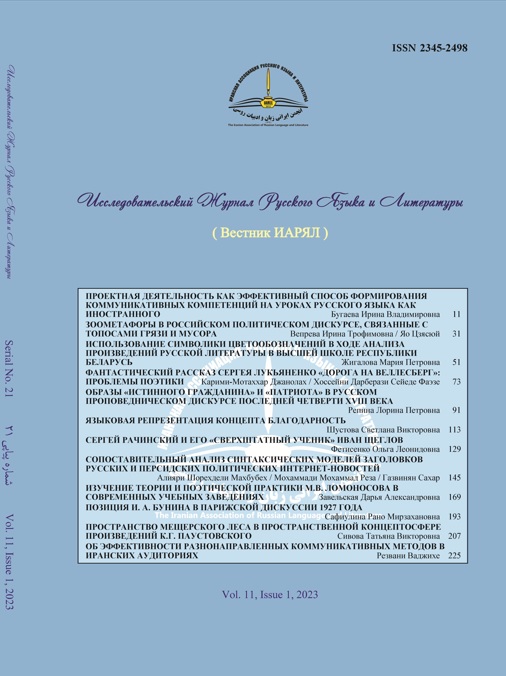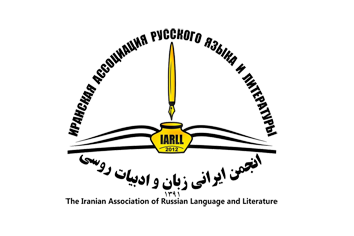ИСПОЛЬЗОВАНИЕ СИМВОЛИКИ ЦВЕТООБОЗНАЧЕНИЙ В ХОДЕ АНАЛИЗА ПРОИЗВЕДЕНИЙ РУССКОЙ ЛИТЕРАТУРЫ В ВЫСШЕЙ ШКОЛЕ РЕСПУБЛИКИ БЕЛАРУСЬ
DOI:
https://doi.org/10.52547/iarll.21.3Ключевые слова:
анализ, символика цвета, художественное произведение, А.В.Жигулин, Ю.П.Казаков, методические рекомендацииАннотация
В статье анализируются фрагменты использования символики цветообозначений в произведениях М. Булгакова («Мастер и Маргарита»), А.С. Пушкина («Подражание Корану»), А.В. Жигулина, Ю.П. Казакова («Голубое и зелёное»), определяется роль и место цветообозначений в ходе интерпретации и анализа произведения, в постижении читателем внутреннего мира писателя, персонажа, духовного мира и характера лирического героя, художественного мира произведения в целом. Предлагается схема колористического анализа и методические рекомендации, которыми могут воспользоваться читатели, обучающиеся в высшей школе, преподаватели; приводятся примеры фрагментов практических занятий и творческих работ (А. В. Жигулин, «Чёрные камни»; Ю.П. Казаков, «Голубое и зелёное») для разных уровней обучения. Сделан вывод о том, что такое прочтение поэтических и прозаических текстов с осмыслением символики цветообозначений, цветового спектра чувств героев, составлением партитуры переживаний героя, помогает раскрыть колорит эпохи и социума, психологические черты персонажа, активность/пассивность участия героя в действиях, разворачивающихся на страницах произведения.
Библиографические ссылки
- Аграшенков А. (1997). Психология на каждый день. М. : Изд-во АСТ, С. 25 – 27, 480 с.
- Жигалова М.П. (2004). Типология анализа произведений русской литературы: монография. Брест : БрГУ. 300с.
- Жигалова М.П. (2003). Русская литература XX века в старших классах: пособие для учителей общеобразовательной школы. Рекомендовано Центром учебной книги и средств обучения Национального института образования. Мн. : Аверсэв. 220с.
- Жигалова М.П. (2011). Интерпретация и анализ в литературе: теория и практика: монография. Брест. 2-е изд., доп. Брест : БрГУ. 269с.
- Жигалова М.П. (2008). Методика преподавания русской литературы. Курс лекций для студентов заочной формы обучения филологического факультета. Брест : «БрГУ имени А.С. Пушкина». 95с.
- Жигалова М.П. (2010). Методика преподавания русской литературы. Учебно-методическое пособие. Брест : БрГУ имени А.С.Пушкина. 213с.
- Жигалова М.П. (2008). Символика цветообозначений в «Слове о полку Игореве» //Матэрыялы міжнароднай навуковай канферэнцыі, прысвечанай 85-годдзю з дня нараджэння У.А. Калесніка. “Слова аб палку Ігаравым у літаратуры і духоўнай культуры славянскіх народаў”. Брэст : “Альтернатива”. С. 283-287.
- Колесов В.В. (1986). Свет и цвет в «Слове о полку Игореве» // «Слово о полку Игореве». 800 лет: Сборник. М. : Советский писатель. С. 220.
- Калимуллин А.М., Жигалова М.П., Ибрашева А.Х., Кобылянская Л.И., Лодатко Е.А., Нурланов Е.Б. (2020). Постсоветская идентичность в педагогическом образовании: прошлое, настоящее, будущее // Education and Self Development. Volume 15. Ф 3. Образование и саморазвитие, Т.15. № 3. С.145-163.
- Жигалова Мария, Карими-Мотаххар Джанолах, Яхьяпур Марзие (2011). Русская литература: анализ, вопросы, задания: уч. пос. для иранской аудитории / Иран – Тегеран : Издательство: «Марказ – е нашр-е данешгахи» (при министерстве наук, исследований и технологий Ирана). 385с.
- Соколов Б. (2000). Энциклопедия булгаковская. М. : С. 56.
- Штенгелов Е. (1979). Цвет в художественной литературе // Наука и жизнь № 8. ,– С. 12-14.
- Жигулин А. (1989). Черные камни. – Москва : Книжная палата,– С. 5-10. – 240с.
Bibliography
- Agrashenkov A. (1997). Psihologija na kazhdyj den'. M. : Izd-vo AST, S. 25 – 27, 480 s.
- Zhigalova M.P. (2004). Tipologija analiza proizvedenij russkoj literatury: monografija. Brest : BrGU. 300s.
- Zhigalova M.P. (2003). Russkaja literatura XX veka v starshih klassah: posobie dlja uchitelej obshheobrazovatel'noj shkoly. Rekomendovano Centrom uchebnoj knigi i sredstv obuchenija Nacional'nogo instituta obrazovanija. Mn. : Aversjev. 220s.
- Zhigalova M.P. (2011). Interpretacija i analiz v literature: teorija i praktika: monografija. Brest. 2-e izd., dop. Brest : BrGU. 269s.
- Zhigalova M.P. (2008). Metodika prepodavanija russkoj literatury. Kurs lekcij dlja studentov zaochnoj formy obuchenija filologicheskogo fakul'teta. Brest : «BrGU imeni A.S. Pushkina». 95s.
- Zhigalova M.P. (2010). Metodika prepodavanija russkoj literatury. Uchebno-metodicheskoe posobie. Brest : BrGU imeni A.S.Pushkina. 213s.
- Zhigalova M.P. (2008). Simvolika cvetooboznachenij v «Slove o polku Igoreve» //Matjeryjaly mіzhnarodnaj navukovaj kanferjencyі, prysvechanaj 85-goddzju z dnja naradzhjennja U.A. Kalesnіka. “Slova ab palku Іgaravym u lіtaratury і duhoўnaj kul'tury slavjanskіh narodaў”. Brjest : “Al'ternativa”. S. 283-287.
- Kolesov V.V. (1986). Svet i cvet v «Slove o polku Igoreve» // «Slovo o polku Igoreve». 800 let: Sbornik. M. : Sovetskij pisatel'. S. 220.
- Kalimullin A.M., Zhigalova M.P., Ibrasheva A.H., Kobyljanskaja L.I., Lodatko E.A., Nurlanov E.B. (2020). Postsovetskaja identichnost' v pedagogicheskom obrazovanii: proshloe, nastojashhee, budushhee // Education and Self Development. Volume 15. F 3. Obrazovanie i samorazvitie, T.15. № 3. S.145-163.
- Zhigalova Marija, Karimi-Motahhar Dzhanolah, Jah'japur Marzie (2011). Russkaja literatura: analiz, voprosy, zadanija: uch. pos. dlja iranskoj auditorii / Iran – Tegeran : Izdatel'stvo: «Markaz – e nashr-e daneshgahi» (pri ministerstve nauk, issledovanij i tehnologij Irana). 385s.
- Sokolov B. (2000). Jenciklopedija bulgakovskaja. M. : S. 56.
- Shtengelov E. (1979). Cvet v hudozhestvennoj literature // Nauka i zhizn' № 8. ,– S. 12-14.
- Zhigulin A. (1989). Chernye kamni. – Moskva : Knizhnaja palata,– S. 5-10. – 240s.
Загрузки
Опубликован
Как цитировать
Выпуск
Раздел
Лицензия
Copyright (c) 2023 Исследовательский Журнал Русского Языка и Литературы

Это произведение доступно по лицензии Creative Commons «Attribution» («Атрибуция») 4.0 Всемирная.
![]()
"Creative Commons Attribution 4.0 International (CC-BY 4.0)"


